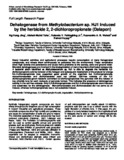Dehalogenase from Methylobacterium sp. HJ1 induced by the herbicide 2, 2-dichloropropionate (Dalapon)
- Global styles
- MLA
- Vancouver
- Elsevier - Harvard
- APA
- Help

Download URL
www.academicjournals.orgDate
2008Author
Page views
2,215ASFA keyword
Taxonomic term
Metadata
Show full item record
Share
Abstract
Heavy industrial activities and agricultural processes require consumption of many halogenated compounds, and release them continuously as pollutants into the environment. These xenobiotics show high toxicity and persistence and cause many problems to the society, soils and ground water. Microbial dehalogenases are involved in the biodegradation of many important chlorinated compounds. A bacterial strain identified as Methylobacterium sp. HJ1 is able to degrade the herbicide 2,2-dichloropropionic acid by removal of the halogen and subsequent metabolism of the product for energy. D,L-2-chloropropionate also supported good growth of the organism but 3-chloropropionate, monochloroacetate and dichloroacetate were not utilized. Cell-free extracts of the 2,2-dichloropropionate-grown bacteria converted 2,2-dichloropropionate into pyruvate with the release of two chloride ions for each molecule of pyruvate formed. This indicates the presence of dehalogenase activity in the cell-free extracts. Only 2,2-dichloropropionate and D,L-2-chloropropionate were inducers and substrates for the dehalogenase. Monochloroacetate and dichloroacetate did not serve as an inducer, whereas 3-chloropropionate was a non-substrate inducer.
Suggested Citation
Jing, N. H., Taha, A. M., Pakingking, R. V., Jr., Wahab, R. A. B., & Huyop, F. (2008). Dehalogenase from Methylobacterium sp. HJ1 induced by the herbicide 2, 2-dichloropropionate (Dalapon). African Journal of Microbiology Research , 2(2), 32-36. http://hdl.handle.net/10862/91
Type
ArticleISSN
1996-0808Collections
- Journal Articles [1229]



